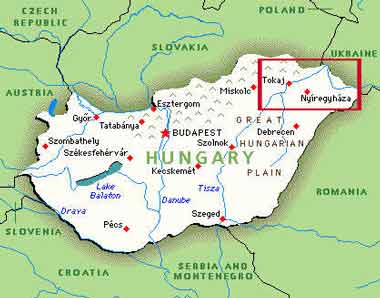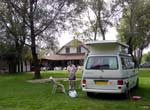|
|
HUNGARIAN RHAPSODY Week 5 |
||
|
There's only one reason to go to Tokaj - to sample (even if not to buy at over-inflated prices) their wines. The town of Tokaj lies at the foot of the Zemplén Hills, whose south facing slopes are an endless vista of vines. Tokaj wines are produced by a unique process. Summer warmth is trapped in the volcanic soil, allowing a delayed harvest until October, by which time many of the grapes are overripe and botrytized (affected by a beneficial rot which shrivels the grapes making them extra sweet).
These Aszú grapes, as they are called, are hand- picked, and pressed separately in small casks called puttony and the sweet aszú juice added to the normally fermenting grapes. The resultant sweet Tokaj Aszú wines are graded according to the number of puttonys of aszú juice added. The highest rated six puttony wines are very expensive; Ł30 for a small bottle is not unusual, but if sweet dessert wines are to your taste, the Tokaj "King of wines and wine of kings" (as Louis XIV praised them) is superb. Photo 1, with its supplementary close-up, shows the 2005 Tokaj grapes already shrivelling to form their aszú berries. We visited the Hímesudvar cellars where we tasted 6 of the Várhelyi family's wines from grape varieties such as Sárgasmuskokály, Furmint, Hárslevelű, and of course the Aszú. The tasting session was highly educative and, although our taste is for dry whites, we did bring some samples of Tokaj for Christmas. Our base at Tokaj was Camping Tiszavirág, just 10 minutes walk from town, on the banks of the Tisza, Hungary's second major river and very much the theme of this week's explorations. Although midges on the river bank were irritating, the beautiful setting and morning mist over the river more than compensated (Photo 2). Camp site prices in Hungary are typically 2,700 forints a night (around Ł8) and on the smaller family run sites, hospitality is genuinely warm. On our way north up the Hernád valley, we passed through the village of Vizsoly, where the first Bible to be translated into native Magyar by Károlyi Gáspár was printed in 1590; the significance of this on the development of Hungarian as a written language, at a time when Latin was the official language of both the Austrian Habsburg rulers and the Papacy, was similar to the impact in England of Tyndale's and Cranmer's translations of the Bible into English. The original 1590 edition of the translation was displayed in the village church. We camped that night in the northern Zemplén Hills, Hungary's wildest region, close to the village of Pálháza. The northernmost settlement in Hungary close to the Slovak border is Hollóháza where we visited the village's famous porcelain factory and its ultra-modern Catholic church built in the 1970s when the Kárdár regime was buddying up with the Vatican to boost its failing image. Our final stop in the north was the town of Sárospatak (Shar-rosh-pot-ok), where a visit to the town's Calvinist College helped us to understand the significance of the Reformation in Hungarian history and to explain to co-existence of Catholic and Reformist Protestant churches in so many towns and villages. Following the disastrous defeat at Mohács in 1526, the Magyars languished under a 150 year dark age of Turkish barbarism. Having missed out on Renaissance enlightenment under which western Europe flourished in the 16th century, the Hungarian people embraced the Reformist teachings of Luther and Calvin, and in many parts of the country, Protestantism gained ascendancy over Catholicism, the religion of the ruling Austrian-Habsburgs. The Calvinist College at Sárospatak with its magnificent Great Library, became a famous centre of learning, gaining the town the rather over-grandiose title of 'Hungarian Cambridge'. The town is also blessed (or cursed, depending on your tastes) with a clutch of buildings designed by the famously eccentric Hungarian architect, Imre Makovecz. Crossing the mighty river Tisza, we travelled to Hungary's far eastern region of the Erdőhát (in Magyar, the same meaning as the Latin-derived Transylvania - 'beyond the woods', from the dense oak woods which used to cover what is now post-Trianon the only remaining Hungarian part of former Transylvania). The isolated and impoverished villages along the Ukrainian and Romanian borders retain beautiful examples of traditional rural architecture, art and customs, but also present vivid images of impoverished life styles, particularly among the Roma folk who form a large proportion of the local inhabitants. Calvinism flourished in these parts from the 16th century, but in the bigotry of the Catholic led Counter-Reformation, the Protestant Church was subjected not only to ruthless persecution but also pettily restrictive regulations: Calvinist churches were not allowed to have stone-built intrinsic spires, but were obliged to built separate wooden bell-towers, so that they were always visually inferior to the neighbouring Catholic church. Photo 3 shows one of many such examples of free-standing beautiful wooden bell-towers, from the Calvinist church at Gemsze. The village of Szatmárecseke (Sot-mar-ech-e-ke) contains unique examples of another ancient Magyar custom: in the local cemetery there are 600 or so oak wooden grave-markers (kopjafa), shaped like upturned boats and carved with a complex pattern of notches indicating the social position and age of the deceased (Photo 4). Clearly the tradition is still alive, since some of the graves are as recent as 2004. These are thought to represent ships to transport the soul of the departed to the other world, according to ancient Finno-Ugric mythology. Just along from here, we stood on the banks of the Tisza river looking across at the Ukraine. Expensive visas, lengthy form-filling, even longer delays at the border eased by overt back-handers to border guards are, according to Hungarians we spoke to, the only way in; but then, our informants generally added, why would you want to go there anyway? We satisfied ourselves with photos across the river - see slide on Home Page. In passing through villages along the Tisza, one could not help noticing the dark-skinned and impoverished- looking Romas, the Gypsies (cigány in Magyar). The origins of the Roma remains of mystery, but it is thought that this nomadic people migrated into central Europe from Northern India some 500 years ago. They now tend to settle in poorer housing in cities such as Miskolc or the dilapidated cottages segregated at the outskirts of villages, doing menial work or just hanging around aimlessly. Although their rights are enshrined in the 1989 Hungarian constitution, as with all minorities, they are subject to indiscriminate prejudice and persecution, a scapegoat for society's ills (rise in crime, benefits fraud, work-shy, prostitution - does it sound familiar?). Our base for the stay in Erdőhát was Vízimalom Camping at Túristvándi, open all year round and kept by the wonderfully hospitable Marika Erdélyi and her son Gárbor, both of whom spoke fluent English. On the first evening, we were treated to a display of traditional Magyar folk dancing, and invited to share a traditional Hungarian supper with Marika's family on the second evening. We had enjoyed many excellent campsites and welcoming hospitality across Hungary, but none more than at Vízimalom Camping. If you come to this part of Hungary, be sure to stay there; visit their web site on www.turvizimalom.hu/english We shall long remember our stay at Vízimalom, and when we left, Marika presented us with parting gifts of her own produce including ground paprika. We do thank her and her family for their generosity.
From Garbolc, the most easterly village in Hungary, we
took a narrow lane towards the Ukrainian border; would it be fenced
across, we wondered, patrolled by armed border guards in true le Carré
fashion. But anticlimactically
it simply ended at a flood control embankment. We had reached the extreme
easterly limit of this trip's travels - everything from now will be part of the
long journey home. But there's still lots more to come, so keep watching
for news next week of the Great Plain ... As the Magyars say, Szia. Sheila
and Paul Published:
Wednesday 21 September 2005 |



